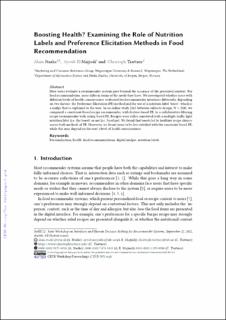Boosting Health? Examining the Role of Nutrition Labels and Preference Elicitation Methods in Food Recommendation
Chapter
Published version

Åpne
Permanent lenke
https://hdl.handle.net/11250/3040188Utgivelsesdato
2022Metadata
Vis full innførselSamlinger
Originalversjon
In: IntRS’22: Joint Workshop on Interfaces and Human Decision Making for Recommender Systems.Sammendrag
How users evaluate a recommender system goes beyond the accuracy of the presented content. For food recommendation, users differ in terms of the needs they have. We investigated whether users with different levels of health consciousness evaluated food recommender interfaces differently, depending on two factors: the Preference Elicitation (PE) method and the use of a nutrition label ‘boost’, which is a nudge that is explained to the user. In an online study (2x2 between-subjects design; 𝑁 = 244), we compared a constraint-based recipe recommender, with feature-based PE, to a collaborative filtering recipe recommender with rating-based PE. Recipes were either annotated with a multiple traffic light nutrition label (i.e. the boost), or not (i.e., baseline). We found that boosts led to healthier recipe choices across both methods of PE. Moreover, we found users to be less satisfied with the constraint-based PE, while this may depend on the user’s level of health consciousness.
